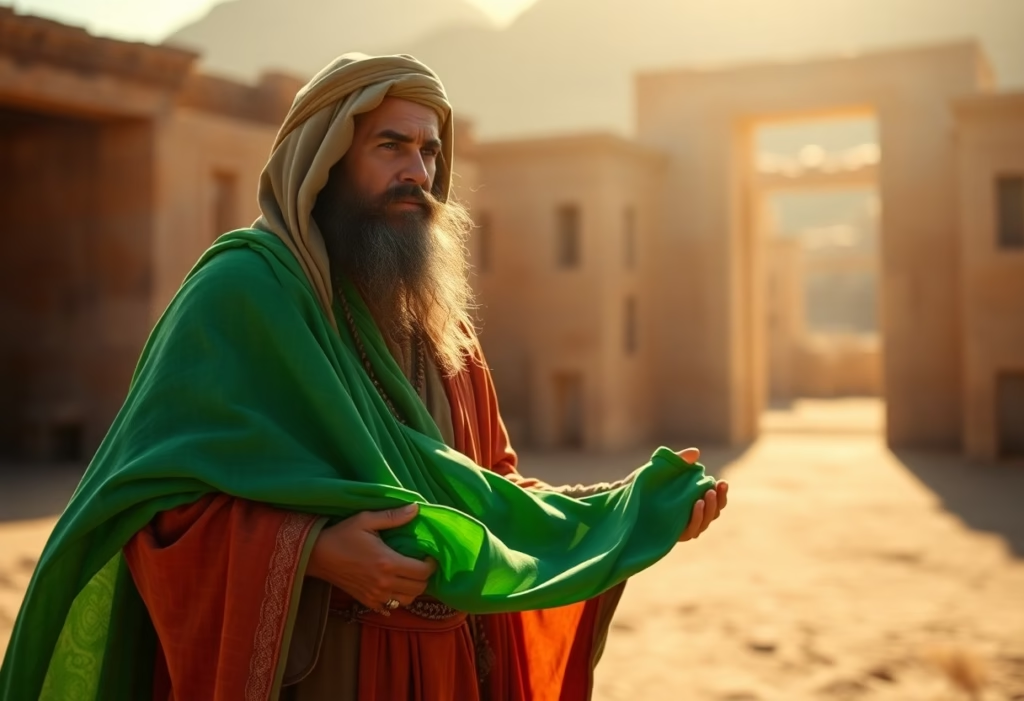There’s a fascinating tidbit you probably didn’t know: the Prophet had a favorite color! Yes, you read that right. In a world where everyone claims to have a favorite something, it turns out that the Prophet’s choice carries rich historical significance and has influenced millions over the years. So why should you care? Well, this colorful insight might just add a splash of depth to your understanding of Islamic traditions and make for an interesting conversation starter! Buckle up, and let’s probe the vibrant world of color symbolism in this delicate context.
Key Takeaways:
- The Prophet Muhammad had a favorite color, which is reported to be green, affectionately connected to nature and paradise in Islamic culture.
- The significance of colors in Islam extends beyond personal preference, symbolizing various spiritual concepts and cultural identity.
- Understanding the Prophet’s preferences helps in fostering a deeper appreciation for the traditions and values within the Islamic community.
The Colors of Prophethood: A Historical Palette
Your exploration of the Prophet’s favorite color opens up a broader conversation about the rich tapestry of colors associated with his time. The historical palette includes hues that were not just aesthetic choices but also held profound meanings. Each color seemed to echo the spiritual and cultural values of the era, from vibrant reds symbolizing bravery to calming greens representing peace. This colorful legacy continues to influence Islamic art and architecture, allowing you to immerse yourself in a vibrant history that’s anything but dull.
The Prophet’s Favorite: Unpacking Blue
Blue wasn’t just a favorite; it was a deep connection to spirituality and divine presence in the life of the Prophet. This color, often associated with the heavens, resonates with tranquility and depth. You might find it fascinating that blue garments were favored by him, symbolizing protection and serenity. This preference illustrates how colors in the Prophet’s life served a purpose beyond mere decoration.
Symbolism of Colors in Islamic Tradition
Colors in Islamic tradition are more than aesthetic choices; they are laden with symbolism and meaning. Different hues convey distinct sentiments and moral lessons, facilitating a richer understanding of diverse aspects of faith. For instance, green is synonymous with paradise and often represents the Prophet himself, while black might stand for strength and authority. These colors did not merely decorate but rather embodied messages that shaped spiritual and social practices.
Delving into the symbolism reveals a fascinating interplay between color psychology and spirituality. Green’s significance, widely recognized in Islamic art, represents sustenance and life, echoing the concept of gardens in paradise. Meanwhile, shades like yellow often symbolize warmth and prosperity, enriching your understanding of how deeply intertwined colors and beliefs can be. This colorful lexicon continues to resonate in modern contexts, illustrating that even in today’s world, these hues breathe life into Islamic identity.
The Artist’s Eye: Colors as Cultural Signifiers
Colors have always conveyed more than mere aesthetics; they carry rich meanings rooted in cultural history. In ancient societies, specific shades often represented social status, spiritual beliefs, or even political ideologies. For example, the vibrant red worn by nobility signified power, while earthy tones connected the everyday citizen to the land. As you research deeper, you’ll discover how each era breathed its own interpretation into colors, creating a tapestry of significance that transcends time and place.
How Color Representation Varied in Different Eras
Throughout history, the perception of color has fluctuated dramatically. In ancient Egypt, blue symbolized the divine, while in medieval Europe, it was often associated with royalty. Fast forward to the Renaissance, when colors began to reflect human emotions, laying the groundwork for modern art. These shifting interpretations reveal how deeply interconnected color is with societal values and beliefs across various time periods.
The Role of Color in Ancient Arabian Culture
Ancient Arabian culture held a profound appreciation for color, viewing it as an important part of their rich narrative tapestry. Certain colors indicated tribal affiliations, while others denoted honor or bravery. For example, the color black was associated with strength and resilience, often donned by warriors before battle. Moreover, vibrant hues were not just reserved for textiles and architecture; they permeated poetry and stories, emphasizing emotions and values. In daily life, you’ll find colors shaping communal identities, fostering connections, and even enhancing social hierarchies, making every shade imbued with deeper significance in ancient Arabian society.
The Psychological Shade: Colors and Their Influence on Behavior
Color psychology plays a fascinating role in our daily interactions and environments. Different hues can evoke various emotions and responses, subtly shaping our behavior and decision-making. For instance, vibrant colors often stimulate excitement and creativity, while muted tones can foster a sense of calm. Understanding the impact of color can enhance your personal space, influence communication, and even improve your mental well-being.
The Emotional Resonance of Blue in Religious Contexts
Blue has been a prominent color in religious symbolism, often representing divinity, tranquility, and spirituality. In various faiths, it evokes a profound emotional connection, appearing in sacred texts and art as a reminder of the heavens. For many believers, blue reflects peace and hope, creating a calming atmosphere during prayer or meditation.
How Colors Shape Perceptions of Authority and Compassion
Colors wield significant power in shaping how you perceive authority and compassion within social settings. For example, deep shades of red often exude strength and assertiveness, making leaders appear more formidable and confident. On the flip side, softer colors like light blue or pastel green can evoke feelings of approachability and warmth, fostering a sense of compassion. Studies show that people are drawn to leaders dressed in these calming hues, interpreting their tone as more empathetic and understanding. Who knew your wardrobe could communicate so much?
Color Choices in Modern Islamic Practices
In today’s world, colors in Islamic practices continue to hold significant weight, bridging tradition and contemporary influence. Many mosques feature vibrant hues such as blue and green, symbolizing tranquility and paradise. This blend keeps the faith dynamic while connecting believers to their rich heritage. Everyday practices also showcase color, from the vibrant shades adorning prayer rugs to the colors of silk used for *hijabs*, reflecting personal taste intertwined with devotion.
The Continuation of Favorite Colors in Contemporary Islamic Art
The use of favorite colors persists in contemporary Islamic art, where artists often draw inspiration from historical palettes while innovatively merging them with modern styles. For instance, artists utilize bold reds, calming blues, and radiant yellows to evoke emotions and narrate stories deeply intertwined with their cultural identity. This revival not only pays homage to traditions but also invites a fresh audience to appreciate the diversity and vibrancy found within Islamic creativity.
Favorite Colors in Islamic Fashion: Tradition Meets Trend
Islamic fashion reflects a harmonious blend of tradition and modernity, showcasing a colorful revival of favorite hues. Designers incorporate deep greens, striking reds, and warm earth tones, appealing to a global audience while maintaining cultural essence. Whether it’s a flowing *abaya* or a chic *kaftan*, the colors chosen create a vibrant dialogue between the past and contemporary aesthetics, allowing wearers to express their faith and personal style.
Color plays a vital role in showcasing your individuality through Islamic fashion. Imagine slipping into a stunning blue *abaya* that mirrors the soothing skies or donning a radiant saffron scarf that lifts spirits instantly. In the fashion world, these *hues* allow you to celebrate cultural roots while effortlessly progressing with modern trends. The intersection of appreciation for traditional shades and modern silhouettes not only helps you stand out but fosters a deeper connection with your identity, proving that the colors you choose genuinely tell your story.
Rethinking Religious Symbolism Through Color
Colors have the profound ability to express faith and spirituality in ways that words often cannot. As you explore religious symbolism, consider how hues like deep green or vibrant blue invoke specific feelings and meanings across various traditions. This isn’t merely abstract; colors resonate with followers, turning into symbols of devotion, identity, and communal belonging, ultimately shaping how faith is expressed and celebrated globally.
What Color Preferences Reveal About Faith and Identity
Your favorite color might extend beyond personal preference, embodying deeper connections to your beliefs. For example, the predominance of white in certain Christian ceremonies symbolizes purity, while the use of black in others signifies mourning and reflection. These choices weave together individual identities with cultural narratives, underscoring how color preferences can reveal both personal convictions and collective identities within religious experiences.
The Potential for Color to Bridge Divides in a Global Context
Colors can serve as a common language, fostering unity among diverse communities. Engaging with popular colors across various cultures—such as the uplifting properties of yellow in Hindu traditions or blue in Islamic art—illustrates how color can transcend boundaries. Interfaith dialogues increasingly harness color to showcase shared values, paving the way for more profound understanding and cooperation, making the world a little more connected.
In a world often divided by belief systems, utilizing color as a bridge can have transformative effects. Consider festivals like Diwali and Ramadan, where vibrant colors symbolize joy and spirituality, drawing in participants from various backgrounds. These shared experiences create avenues for collaboration and appreciation, subtly dismantling misconceptions through the universal language of color. This not only cultivates a sense of belonging but also highlights the unique beauty of each culture’s traditions, making color a powerful tool for peace and understanding in our global tapestry.
To wrap up
Drawing together the threads of this colorful tale, it’s fascinating to think that even the Prophet had a favorite hue! Who knew that a simple shade could spark such vibrant discussions in your mind? Next time you see that beloved color in a sunset or a new outfit, you can smile knowing it’s more than just aesthetic—it’s a link to a great historical figure. So, wear that color with pride; you’re not just making a statement, you’re continuing an age-old tradition of love for the palette of life!
Q: What was the Prophet Muhammad’s favorite color?
A: According to various Islamic traditions, the Prophet Muhammad favored the color green. This is often associated with nature, fertility, and paradise in Islamic culture. Green became a symbol of Islam and is frequently used in Islamic art and architecture. It is also suggested that the Prophet wore garments of this color, reflecting its significance in his life and teachings.
Q: Why is the color green significant in Islam beyond the Prophet’s preference?
A: The significance of green in Islam extends beyond the Prophet’s personal preference. It is considered a color associated with life, growth, and renewal, embodying the essence of paradise as described in the Quran. The color is prominently featured in Islamic flags and decorations, symbolizing hope and prosperity. Many mosques are decorated with green motifs, emphasizing its spiritual importance within the faith.
Q: Are there any other colors that are historically associated with the Prophet Muhammad?
A: While green is widely acknowledged as the Prophet Muhammad’s favorite color, other colors such as white and black also hold significance in Islamic tradition. White is often associated with purity and is commonly worn during important religious occasions, while black is traditionally worn during mourning. Together, these colors represent different aspects of life and spirituality in Islam, reflecting the diversity of the Prophet’s teachings and the cultural practices that evolved over time.

